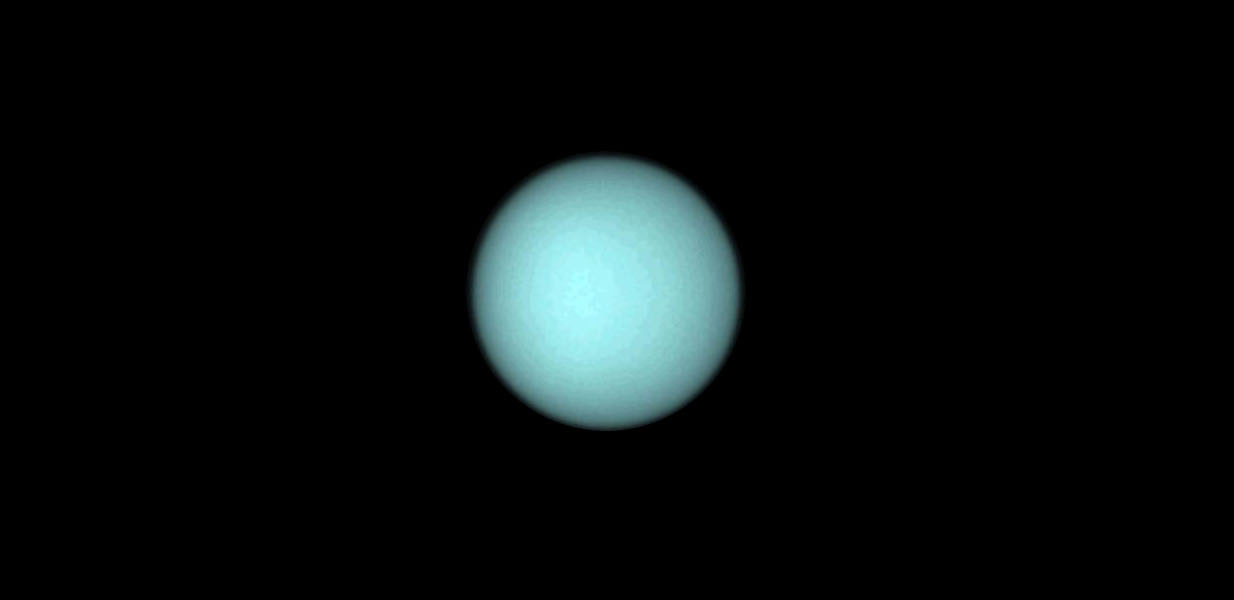
Observing Uranus in 2013
September 2013 :
At nearly twice the distance from the Sun as Saturn, Uranus is the first planet to be discovered during the age of the telescope. Although (just barely) naked-eye visible, it had not been known since ancient times like the five classical planets we often feature in our telescopes during observatory hours.
Although it is a large planet at nearly four times the diameter of Earth, and it shines relatively brightly in our sky (compared with some of our solar system's smaller or more distant objects), Uranus fails to exhibit much detail in even the largest telescopes and but it is nonetheless rewarding to find and observe.
At magnitude 5.8, Uranus is certainly naked-eye visible to observers with good vision and access to a dark site, but it is best observed in binoculars, in which its subtle aqua-green color becomes apparent and its lack of twinkle helps to distinguish itself from the background stars. Throughout 2013 and 2014, our seventh planet spends its time among the stars of Pisces, the fishes about 13 degrees southeast of Algenib (γ Peg), the southeasternmost star of the Great Square. Along this section of the ecliptic we are looking at a fairly steep angle southward out of the plane of the Milky Way galaxy and as such the sky is rather sparsely populated. This notable lack of dense starfields will make Uranus rather easy to find.
To get yourself oriented, first locate the Great Square. Note the distance between Alpheratz (a And) and Algenib (y Peg), the two stars that make up the eastern side of the square. Over the next several months, Uranus will be about the same distance south by southeast of Algenib. If Aries is visible, a second frame of reference can be made by drawing a line from Hamal (α Ari) through Sheratan (β Ari) and extended about five and one-half times the distance towards the west. Once you get in the neighborhood of Uranus, you'll probably want to use the 4.4 magnitude star δ (delta) Piscium as your reference star in your binoculars or finder scope. Delta will be about 4.5 degrees northeast of Uranus, so place the star towards the top of your field of view. Once you've located this star field, the finder chart will help you locate Uranus for the remainder of 2013. The points on the map correspond to its position on each successive Saturday night and indicate the westward (retrograde) motion of the planet until it is stationary on December 18.
At opposition on October 4, Uranus will be 19 AU (2.85 billion kilometers) from Earth. While most of the other planets will vary significantly in brightness as their relative distances from Earth change, Uranus is far enough away that the change in distance is relatively small, and as such, its brightness in our sky varies by less than a quarter magnitude. At its brightest (at opposition) it shines at magnitude 5.7. The fact that it varies so little in brightness helps to make it more easily identifiable once you are familiar with how it appears in your sky and optics.
Now that you have seen Uranus, watch its changing position over the course of a few days or weeks, as this is likely the only dynamic aspect of observing this relatively featureless planet you'll notice. On a night of excellent seeing, even the largest telescopes will not reveal much in the way of "surface" detail on the planet's 3.7 arcsecond disc. Observing visually, you might notice limb darkening in a larger scope, which gives the planet a distinct 3-D appearance. A CCD imager with the right filters might be able to eke out some subtle cloud detail. If you have a larger telescope (12 inches or larger) you can try to spot some of its brighter satellites. Of its 27 known moons, four of them shine at or brighter than 15th magnitude. Titania and Oberon are your best bets, as they are about magnitude 14.5 and will be elongated to just over 30 arcseconds from the disc of Uranus. Keep in mind that Uranus' rotational axis and the orbital plane of its larger satellites is tilted 98° relative to the ecliptic, so the moons will be best observed when they are elongated roughly north and south of the planet. There is a handy moons of Uranus finder utility on Sky & Telescopes' web site at http://www.skyandtelescope.com/observing/objects/javascript/3310476.html.
Have fun observing our solar system's enigmatic seventh planet, and let us know if you're able to spot it naked-eye. We'd also like to publish your images or Uranus and its moons in a future issue of The Skyscraper.



